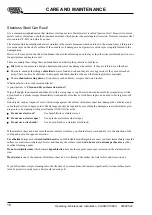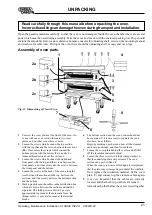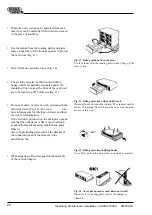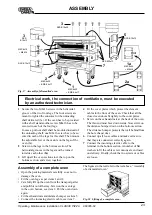
18
Operating Maintenance Installation CLASSIC PIZZA 860005-02
CARE AND MAINTENANCE
Stainless Steel Can Rust!
It is a common misapprehension that stainless steel cannot rust. Stainless steel is called ”passive steel” because it contains
metals such as chromium, or both chromium and nickel, which protect the metal against corrosion. However, stainless steel
also contains 70-80% iron which can rust.
The element which normally makes steel stainless is the metal chromium, which oxidizes in the air and forms a thin protec-
tive oxide layer on the steel’s surface. If the oxide layer is damaged, a new protective oxide layer is rapidly formed in the
damaged area.
However, if some dirt on the sheet iron hinders the acid from forming an oxide layer, the otherwise stainless sheet iron is no
longer stainless and begins to rust.
There are mainly three things that can break down and destroy the protective oxide layer.
Dirt
such as food remains, dough, chemicals, and water can damage the surface, if they are left to dry on the sheet.
There are, among other things,
chlorides
in water, food and salt and they are very aggressive if they are not washed
away. There can also be chlorides in detergents and these should not be used for cleaning stainless materials.
The m
echanical wearing down
of iron objects such as knives, scrapers and wire brushes.
What should I do to avoid corrosion attacks?
A principal rule is:
Clean and dry surfaces do not rust!
Wipe off dough, food remains and other dirt with a wet sponge or rag. Dried-in dirt can be carefully scraped away with a
nylon brush or a plastic scraper. Immediately wash and dry all surfaces. A rubber scraper can be used to dry large smooth
surfaces.
Iron objects, such as wagons of steel, which scrape against the surface of stainless sheet iron, damage the oxide layer and
cause the sheet iron to begin to rust. The damage can only be repaired by smoothing the damaged area with stainless grin-
ding tools or by cleaning with special liquids (10-20% Nitric acid).
Do not use steel wool!
Use Scotch-Brite or stainless wool.
Do not use a steel scraper!
Use a plastic or stainless steel scraper.
Do not use a wire brush!
Use a nylon brush or a stainless steel brush.
If the stainless sheet iron has a smoothed-over surface structure, you should always wash and dry it in the direction of the
cutting and not in the opposite direction.
Use alkaline
detergents but
not chloride-based
ones
.
If chloride-based detergents are used, you must immediately rinse the
surface several times with plenty of water and then dry the surface clean.
Soda
,
borax
and
natrium perborate
are other
excellent cleaning agents.
Do
not use disinfectants
which contain
hypochlorites
, because these agents cause spot corrosion on the stainless sheet
iron.
Hard water
is one of the enemies of stainless sheet iron. A softening filter makes the water softer and less corrosive.
If you follow these simple cleaning rules, the life time of your machines will increase significantly. A clean surface main
-
tains its protective oxide layer, a dirty surface destroys it!









































